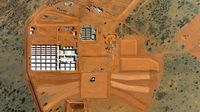On October 20, 2025, the world watched as Australian Prime Minister Anthony Albanese and U.S. President Donald Trump shook hands in Washington, sealing a multibillion-dollar pact that could reshape the global landscape for critical minerals. The agreement, valued at a staggering US$8.5 billion, aims to accelerate rare-earths projects and strengthen bilateral support for supply chains essential to advanced technology and defense hardware. But while miners and investors cheered, experts quickly cautioned that reducing China’s long-standing dominance in this sector will be anything but quick or easy.
The significance of this pact can’t be overstated. According to the Associated Press, the deal marks a major step in the ongoing global race to secure supplies of rare earth metals—vital ingredients for everything from smartphones and electric vehicles to sophisticated military systems. As the world’s appetite for high-tech devices and green energy solutions grows, so too does the urgency to diversify sources of these strategic resources.
Under the terms of the agreement, both countries have committed to jointly invest US$2 billion (about AUD 3.1 billion) in Australian critical minerals projects. Funding support will flow from both the Export-Import Bank of the United States (EXIM) and Export Finance Australia, targeting ventures focused on rare earths, graphite, magnesium, titanium, and scandium. These minerals are not just technical jargon—they’re the backbone of modern defense systems, aerospace components, communications equipment, and next-generation industrial technologies, as highlighted by EXIM following the high-profile meeting.
Among the immediate beneficiaries are the Gina Rinehart-backed Arafura Rare Earths’ Nolans project in the Northern Territory and Alcoa’s gallium project in Western Australia. The Australian government has already committed a US$100 million equity investment in Arafura Rare Earths, signaling just how seriously it’s taking this new chapter. Other companies, including Northern Minerals, Graphinex, La Trobe Magnesium, VHM, RZ Resources, and Sunrise Energy Metals, are set to receive U.S. investment as well, broadening the pact’s reach across the sector.
The market reaction was swift and euphoric. As reported by The Nightly, Arafura Rare Earths’ stock soared 17 percent in early trading, Northern Minerals jumped 7 percent, and Alcoa climbed 7.7 percent. Even established players like Iluka Resources and Lynas Rare Earths saw gains of 5 percent and 1.8 percent, respectively. For many investors, the deal was a clear signal that government backing could turbocharge Australia’s ambitions to become a critical minerals powerhouse.
But let’s not get ahead of ourselves. Experts and analysts, including those cited by Simply Wall St, warn that the journey to true supply chain independence is fraught with challenges. "While a good start, ambitious rare earth projects will be slow and costly," the Associated Press noted, echoing a sentiment that’s hard to ignore. Building out new mines, refining facilities, and transport infrastructure takes time—sometimes years or even decades. And that’s before factoring in environmental reviews, local opposition, and the ever-present risk of cost overruns.
WA1 Resources, a company focused on mineral exploration in Western Australia and the Northern Territory, offers a revealing case study. Despite the sector’s new momentum, WA1 remains pre-revenue and unprofitable, having recently raised A$100 million in equity at a discount. The company’s flagship Luni niobium project has generated excitement, but as Simply Wall St points out, “the immediate impact on WA1’s core risks and project timelines may be more muted until further specific developments unfold.”
For investors, the government’s increased focus is a double-edged sword. On one hand, the US–Australia critical minerals pact shines a global spotlight on rare earths and should support positive sentiment for Australian developers. On the other, the fundamental risks remain: share dilution, continued operating losses, and the uncertainty that comes with early-stage projects. “Government backing could open future funding doors or partnerships if WA1 advances a qualifying project,” Simply Wall St notes, “though near-term catalysts for WA1 may see only limited material change based on this announcement.”
So why all the fuss? The answer, in a word, is China. For years, China has dominated the global supply of rare earths and other critical minerals, often controlling upwards of 80 percent of the market. This stranglehold has made Western governments increasingly nervous, especially as geopolitical tensions rise and supply chain vulnerabilities are laid bare. The new pact is designed to chip away at that dominance, making both the U.S. and its allies less dependent on a single supplier for materials integral to their economies and security.
The Export-Import Bank of the US was clear about the strategic motivation, stating, “By supporting these materials, EXIM is directly contributing to the resilience of US defense supply chains and the reindustrialisation of America’s high-tech manufacturing base.” It’s a bold vision, but one that will require patience and persistence.
Meanwhile, the pact has already produced visible winners and, perhaps, a few skeptics. The Gina Rinehart-backed Arafura Rare Earths’ Nolans project is now flush with immediate funding, and Alcoa’s gallium project has been prioritized as well. For Northern Minerals, the Browns Range rare earths project in the East Kimberley is now on the U.S. radar. These are not minor developments; they represent a significant reorientation of capital and attention toward Australia’s mineral-rich outback.
Yet, the road ahead is dotted with hurdles. As Associated Press and Simply Wall St both emphasize, the process of breaking China’s grip will be slow, expensive, and uncertain. New projects must prove their commercial viability, navigate regulatory mazes, and secure long-term buyers. Investors, for their part, are advised to keep a close eye on companies’ financial health, as the sector’s newfound attention could mask underlying risks.
Still, the momentum is undeniable. The US-Australia pact has injected fresh optimism into a sector that’s often struggled for attention outside of commodity circles. With billions on the table, government support at an all-time high, and a clear mandate to diversify supply chains, the stage is set for a new era in critical minerals. Whether that era arrives sooner or later will depend on how policymakers, companies, and investors navigate the complex terrain ahead.
For now, the world is watching—and so are the markets. As the dust settles on this historic agreement, one thing is certain: the race to secure the minerals of the future has only just begun.





